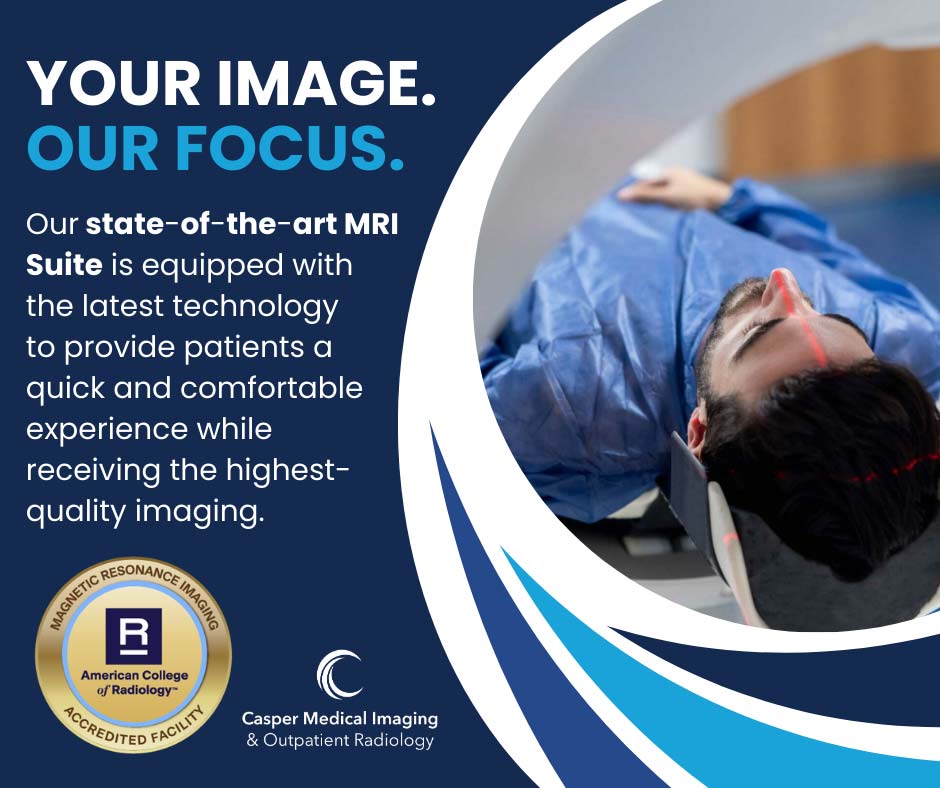asper Medical Imaging & Outpatient Radiology (CMI & OPR) has high standards when it comes to MRI safety at their accredited MRI suite. CMI & OPR’s friendly and compassionate MRI team bring over 75 years of imaging experience to Casper and surrounding communities, ensuring patients receive nothing but the best and safest care. care. But what is magnetic resonance imaging (MRI)? What is it best used for and how do patients benefit from their 3 T High-Field Strength MRI?
MRI machines use radio waves and magnets to take detailed images of the inside the body. MRIs are used to investigate or diagnose soft tissue conditions such as tumors, damaged ligaments, joint injuries, and more. MRIs help physicians determine the source of a patient’s pain or injury and guide further diagnosis and treatment. CMI & OPR uses MRI to image brains, spines, joints, bones, abdomen, breast, prostate, and cardiac.
MRIs use strong magnets to take images of the inside of the body, which requires strict safety practices and standards. The MRI technologists and radiologists at CMI & OPR remain on the frontlines of MRI safety for both their patients and themselves. CMI & OPR’s local, board-certified and fellowship trained radiologists guide the technologists to perform above-standard imaging protocols for every scan.
MRI safety matters down to the finest detail. For example, even clothing choices affect the security of a scan. If an MRI technologist isn’t having a patient change out of regular clothing for an MRI, those garments could be at risk of catching on fire.
“Moisture-wicking, anti-microbial materials, like your Lululemon leggings, aren’t safe to wear during an MRI. While these materials are comfortable, they should never be worn during an MRI because the invisible, silver-embedded microfibers in the fabric can cause burns, or in worse circumstances, fires. At CMI & OPR, we take into account every little detail, down to your moisture wicking clothing, to keep you safe at all times,” says MRI Manager, Misty Dibble.
As an American College of Radiology-accredited facility (ACR), CMI & OPR abide closely to the ACR Manual on MRI Safety to ensure their patients are always safe and comfortable. The ACR Manual is especially useful for ensuring safe practices when using their 3T High-Field Strength MRI. When it comes to higher field strength of an MRI, such as a 3 T, there are a few benefits that set it apart from a 1.5 T (which CMI & OPR’s state-of-the-art MRI Suite also includes).
The 3 T magnet’s strength, plus the openness of the machine itself allows patients to often spend less time in the machine, which is a major bonus for patients that are claustrophobic. Most patients spend about 15-20 minutes inside, as opposed to the traditional 15-90 minutes for other MRI scans. Additionally, 3 T machines produce clearer images to help radiologists see organs, soft tissues, and smaller parts of the body. In fact, it’s best used to acquire images of the brain, spine, soft tissue of joints, and the inside of bones and blood vessels.
Other benefits of the 3T MRI include:
- The imaging speeds of these machines are so fast, they can capture a beating heart!
- Very small structures in the brain are visible at very high resolution to fully diagnose the extent of traumatic brain injury (TBI).
- These machines are able to diagnose orthopedic and neurological injuries that can be missed on traditional MRI.
- The larger, 70 mm bore can accommodate patients up to 500 pounds.
Bottom line: when choosing a facility for imaging, safety should be a top priority. CMI & OPR are at the forefront of safety and their technologists take all precautionary steps to ensure when a patient is in their hands, they’re always safe. Need an MRI? Choose Casper Medical Imaging & Outpatient Radiology and their ACR accredited state-of-the art MRI suite, where safety and innovation come hand in hand. Call to make an appointment today!

